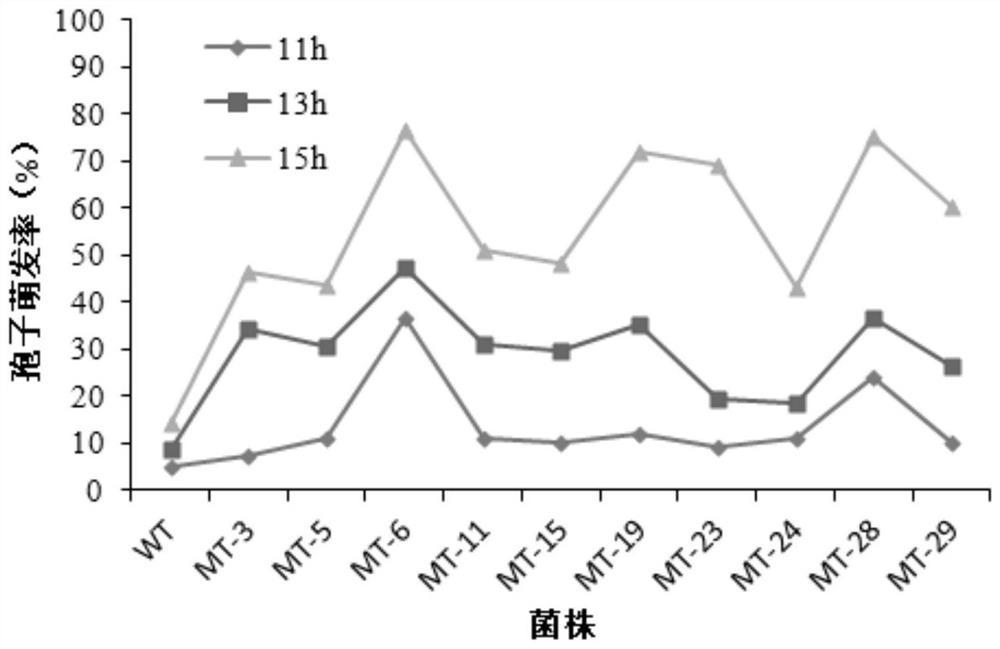A kind of anti-ultraviolet and high-temperature-resistant high-virulence Ijuvium javanica mutagenic strain ijuv-6 and its application
An IJUV-6, anti-ultraviolet technology, applied in the fields of application, fungi, and microbial-based methods, can solve the problem of normal growth pest infestation, unstable control effect of rice pests, and poor control effect of I. japonicus on rice pests. Stability and other issues
- Summary
- Abstract
- Description
- Claims
- Application Information
AI Technical Summary
Problems solved by technology
Method used
Image
Examples
Embodiment 1
[0031] Example 1 Isolation and Identification of the Mutagenic Strain IJUV-6 of I. Javanese
[0032] 1. Source of materials
[0033] The mutagenic strain of I. javanica was derived from the wild strain of I. javanica IJNL-N8. The wild strain of I. javanica IJNL-N8 was collected from the brown planthopper [Nilaparvata lugens(Stal)] worm corpse;
[0034] Potato Dextrose Agar medium (Potato Dextrose Agar, PDA medium): 200g of potatoes, 20g of glucose, 20g of agar, add water and boil to make the total volume 1000mL, and sterilize by autoclaving (121°C, 30min);
[0035] Chapek's medium (Czapek): 30.0 g of sucrose, ammonium nitrate (NH 4 NO 3 )3.0g, dipotassium hydrogen phosphate (K 2 HPO 4 ) 1.0g, magnesium sulfate (MgSO 4 .7H 2 O) 0.5g, potassium chloride (KCl) 0.5g, ferrous sulfate (FeSO 4 ) 0.01g, pour it into a beaker and add water to heat and dissolve to make the total volume 1000mL, then sterilize by autoclave (121°C, 20min);
[0036] Culture conditions: Culture in a...
Embodiment 2
[0106] Example 2 Determination of the pathogenicity of I. javanica mutagenic strain IJUV-6 to white-backed planthopper
[0107] 1. Experimental method
[0108] Insects and host plants for testing: Inoculate the white-backed planthopper adults raised on rice plants in the net room to insect-free rice plants, place them in insect cages (60×60×80 cm), and wait for the white-backed planthoppers on rice plants When the back planthopper develops to the 4th instar nymph, it is ready for use.
[0109] Rice is a conventional cultivar, and potted seedlings with a height of 30 cm after tillering are used in experiments.
[0110] Treatment of the tested strains: inoculate the wild strain (WT) and the IJUV-6 mutagenized strain IJUV-6 on PDA medium, and cultivate them in an incubator (14L: 10D) at 26±1°C for 10 days. Add 0.1% Tween-80 sterile water to collect the spores, break up the spore suspension on a magnetic stirrer, filter the impurities with medical gauze to obtain the spore suspe...
Embodiment 3
[0118] Example 3 Determination of the pathogenicity of I. javanica mutagenic strain IJUV-6 to the electric leafhopper
[0119] 1. Experimental method
[0120] Insects and host plants for testing: Inoculate the adult leafhoppers raised on rice in the net room to insect-free rice plants, place them in insect cages (60×60×80 cm), and wait for the electric leafhoppers on the rice plants to grow. Cicada is standby when developing to 3,4,5 instar nymphs.
[0121] Rice is a conventional cultivar, and potted seedlings with a height of 30 cm after tillering are used in experiments.
[0122]Treatment of tested strains: Inoculate the IJUV-6 mutagenic strain (IJUV-6) in PDA medium, cultivate it in a thermostat (14L: 10D) at 26±1°C for 10 days, and add 0.1% sporulation after sporulation. Spores were collected in sterile water at temperature -80°C, and the spore suspension was dispersed on a magnetic stirrer, then filtered with medical gauze to remove impurities, and the spore suspension ...
PUM
 Login to View More
Login to View More Abstract
Description
Claims
Application Information
 Login to View More
Login to View More - R&D
- Intellectual Property
- Life Sciences
- Materials
- Tech Scout
- Unparalleled Data Quality
- Higher Quality Content
- 60% Fewer Hallucinations
Browse by: Latest US Patents, China's latest patents, Technical Efficacy Thesaurus, Application Domain, Technology Topic, Popular Technical Reports.
© 2025 PatSnap. All rights reserved.Legal|Privacy policy|Modern Slavery Act Transparency Statement|Sitemap|About US| Contact US: help@patsnap.com



